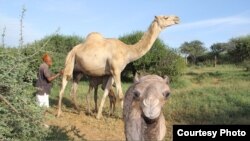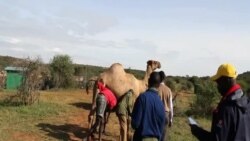ST. LOUIS, MISSOURI —
Camels are known for their ability to travel long distances across the desert without water, but they’re also becoming an increasingly important source of milk for people in drought-prone regions.
That includes East African countries like Kenya, where populations of camels, the single-humped kind technically known as dromedaries, have grown rapidly over the past few decades.
Unpasteurized camel milk
But introducing camels, or any species, to a new region could mean bringing in new diseases, so researchers are studying camel diseases in Kenya to try to assess the risks.
The camels at the Mpala Research Centre in Kenya might sound fierce and, at more than two meters tall, adult dromedaries can be pretty intimidating. But Margaret Kinnaird, Mpala’s executive director, says they don’t deserve their reputation for meanness.
“I’ve never been spat on, I’ve never been bitten, I’ve only been sort of gummed and kissed,” she said.
A couple of years ago, Kinnaird began a project on camel health with Sharon Deem, who directs the Institute for Conservation Medicine at the Saint Louis Zoo in Missouri.
“Camels may have some diseases that, as the human population reaches for camel milk, these diseases could be passed to them,” Deem said.
A growing number of Kenyans are drinking camel milk, most of it unpasteurized.
“These are estimates, but we really believe that up to 10 percent of Kenya’s 40 million people, so we’re talking four million people, probably drink unpasteurized camel milk,” Deem said.
New arrivals
Camels are not native to Kenya. But Kinnaird estimates that over the past 30 years, their number has grown to about three million.
Many have been brought in by immigrants from neighboring countries like Somalia and Sudan, where people have traditionally kept camels. Kenyan ranchers are turning to camels because of their ability to survive with limited water.
“People are learning that they can have camels persist throughout some very severe droughts, where they tend to lose all of their cattle, or a large majority of their cattle,” Kinnaird said.
Unlike cattle and goats, camels can continue producing substantial quantities of milk under drought conditions, which climate scientists predict will become more severe and frequent in Kenya in the future.
"So, I would imagine that given climate change, the role of camels is bound to be even more important than it has been before for those who live in these areas,” said Amos Omore, with the International Livestock Research Institute in Nairobi.
Disease control
With camels becoming more common in Kenya, as well as a significant source of nutrition, Sharon Deem, of the Saint Louis Zoo, believes it’s critical to find out what diseases they might be spreading.
When she began her research on camels, she really didn’t know much about them, so she started hitting the books.
“I became, very quickly, sort-of a camel expert," Deem said. "And I think that first field season I was maybe one of the best camel vets in Kenya.”
That unusual expertise helped Deem gain the trust of some local herders, who were eager to have her check out their camels.
Deem and her colleagues decided to focus on three diseases: brucellosis, trypanosomiasis, and Q fever.
They chose those diseases not only because they could spread to people who drink unpasteurized milk, but because they might also infect Kenya’s abundant wildlife species, like zebras and elephants.
Health risk
With start-up funding from the St. Louis-based animal health and nutrition company Novus International, Deem worked with Margaret Kinnaird and local ranchers to test 150 camels over the course of two years. They collected blood, fecal, and tick samples.
Video showing wildlife veterinarian Sharon Deem of the Saint Louis Zoo drawing blood from a camel at the Mpala Research Centre in central Kenya.
The testing didn’t turn up much brucellosis or trypanosomiasis, according to Deem, but almost a third of the camels, and more than half the ticks, tested positive for Q fever, a bacterial disease that can be fatal in humans.
“So we really feel that Q fever in camels could be very important in this region,” she said.
The next step for Deem and her team will be to take a closer look at Q fever and how it is affecting livestock, people, and wildlife.
She also wants to keep working with Kenyan ranchers on what she calls “camel 101,” basic steps to keep their herds healthy.
Related photo gallery
That includes East African countries like Kenya, where populations of camels, the single-humped kind technically known as dromedaries, have grown rapidly over the past few decades.
Unpasteurized camel milk
But introducing camels, or any species, to a new region could mean bringing in new diseases, so researchers are studying camel diseases in Kenya to try to assess the risks.
The camels at the Mpala Research Centre in Kenya might sound fierce and, at more than two meters tall, adult dromedaries can be pretty intimidating. But Margaret Kinnaird, Mpala’s executive director, says they don’t deserve their reputation for meanness.
“I’ve never been spat on, I’ve never been bitten, I’ve only been sort of gummed and kissed,” she said.
A couple of years ago, Kinnaird began a project on camel health with Sharon Deem, who directs the Institute for Conservation Medicine at the Saint Louis Zoo in Missouri.
“Camels may have some diseases that, as the human population reaches for camel milk, these diseases could be passed to them,” Deem said.
A growing number of Kenyans are drinking camel milk, most of it unpasteurized.
“These are estimates, but we really believe that up to 10 percent of Kenya’s 40 million people, so we’re talking four million people, probably drink unpasteurized camel milk,” Deem said.
New arrivals
Camels are not native to Kenya. But Kinnaird estimates that over the past 30 years, their number has grown to about three million.
Many have been brought in by immigrants from neighboring countries like Somalia and Sudan, where people have traditionally kept camels. Kenyan ranchers are turning to camels because of their ability to survive with limited water.
“People are learning that they can have camels persist throughout some very severe droughts, where they tend to lose all of their cattle, or a large majority of their cattle,” Kinnaird said.
Unlike cattle and goats, camels can continue producing substantial quantities of milk under drought conditions, which climate scientists predict will become more severe and frequent in Kenya in the future.
"So, I would imagine that given climate change, the role of camels is bound to be even more important than it has been before for those who live in these areas,” said Amos Omore, with the International Livestock Research Institute in Nairobi.
Disease control
With camels becoming more common in Kenya, as well as a significant source of nutrition, Sharon Deem, of the Saint Louis Zoo, believes it’s critical to find out what diseases they might be spreading.
When she began her research on camels, she really didn’t know much about them, so she started hitting the books.
“I became, very quickly, sort-of a camel expert," Deem said. "And I think that first field season I was maybe one of the best camel vets in Kenya.”
That unusual expertise helped Deem gain the trust of some local herders, who were eager to have her check out their camels.
Deem and her colleagues decided to focus on three diseases: brucellosis, trypanosomiasis, and Q fever.
They chose those diseases not only because they could spread to people who drink unpasteurized milk, but because they might also infect Kenya’s abundant wildlife species, like zebras and elephants.
Health risk
With start-up funding from the St. Louis-based animal health and nutrition company Novus International, Deem worked with Margaret Kinnaird and local ranchers to test 150 camels over the course of two years. They collected blood, fecal, and tick samples.
Video showing wildlife veterinarian Sharon Deem of the Saint Louis Zoo drawing blood from a camel at the Mpala Research Centre in central Kenya.
The testing didn’t turn up much brucellosis or trypanosomiasis, according to Deem, but almost a third of the camels, and more than half the ticks, tested positive for Q fever, a bacterial disease that can be fatal in humans.
“So we really feel that Q fever in camels could be very important in this region,” she said.
The next step for Deem and her team will be to take a closer look at Q fever and how it is affecting livestock, people, and wildlife.
She also wants to keep working with Kenyan ranchers on what she calls “camel 101,” basic steps to keep their herds healthy.
Related photo gallery








